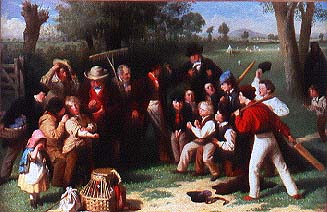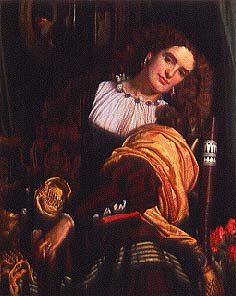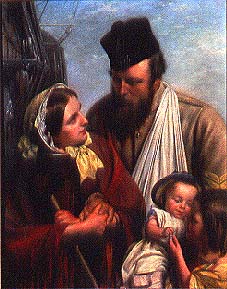

February Issue 2000
Works From FORBES Magazine Collection at Mint Museum of Art
 A phenomenon frequently
occurs at the close of each century whereby interest in the history
and culture of the era at the turn of the previous century undergoes
a revival. The renewal of the Arts and Craft movement and recent
fascination by Hollywood and PBS in the novels of Jane Austen,
Henry James and Thomas Hardy are indications of a revival of interest
in the Victorian era. In the visual arts, the staff of the National
Gallery of Art was surprised by the huge crowds that visited the
exhibition The Victorians in 1997. Art in the Age of
Queen Victoria: Treasures from the Royal Academy of Arts opened
a national tour in Sept. 1999 at Seattle's Frye Art Museum while
The Defining Moment: Victorian Narrative Paintings from The
FORBES Collection has begun an 18-month tour at the Mint Museum
of Art in Charlotte, NC, which will be on view through Apr. 2.
A phenomenon frequently
occurs at the close of each century whereby interest in the history
and culture of the era at the turn of the previous century undergoes
a revival. The renewal of the Arts and Craft movement and recent
fascination by Hollywood and PBS in the novels of Jane Austen,
Henry James and Thomas Hardy are indications of a revival of interest
in the Victorian era. In the visual arts, the staff of the National
Gallery of Art was surprised by the huge crowds that visited the
exhibition The Victorians in 1997. Art in the Age of
Queen Victoria: Treasures from the Royal Academy of Arts opened
a national tour in Sept. 1999 at Seattle's Frye Art Museum while
The Defining Moment: Victorian Narrative Paintings from The
FORBES Collection has begun an 18-month tour at the Mint Museum
of Art in Charlotte, NC, which will be on view through Apr. 2.
Queen Victoria's sixty-four year reign, from 1837-1901, came during England's second golden age. The Industrial Revolution created a new and powerfully wealthy middle class, supplanting the aristocracy in influence and shifting appreciation and patronage of the arts to a new sector. British Imperialism was at its height with colonial rule in India, South Africa and elsewhere. The diminutive monarch, through a sense of duty, transparent honesty and virtue of royal character, restored dignity and popularity to a tarnished crown.
English paintings of the Victorian era portray the optimism and confidence Britons felt about themselves and their own age. In particular, the narrative painting style became a public favorite, encompassing persistent themes relating to Victorian womanhood, ideas about masculinity, imperialism, childhood, rural existence, death and loss, severance and departure, and poverty.
 The Defining Moment:
Victorian Narrative Paintings from The FORBES Magazine Collection
was organized by the Mint Museum of Art and guest curator Dr.
Susan P. Casteras, a Professor of Art History at the University
of Washington and former Curator of Paintings at the Yale Center
for British Art. The exhibition is sponsored by Royal & SunAlliance
USA. After it shows at the Mint Museum, it travels to Nashville's
Cheekwood Museum of Art (May 12 - Aug. 6), the Delaware Art Museum
(Oct. 1, 2000 - Jan. 7, 2001), the Tampa Museum of Art (Jan. 27
- Apr. 22, 2001) and The FORBES Magazine Collection Galleries
in New York (May 1 - June 30, 2001). US Airways is generously
providing air transport for The FORBES Magazine Collection.
The fifty paintings on display are from Old Battersea House, the
Forbes London mansion.
The Defining Moment:
Victorian Narrative Paintings from The FORBES Magazine Collection
was organized by the Mint Museum of Art and guest curator Dr.
Susan P. Casteras, a Professor of Art History at the University
of Washington and former Curator of Paintings at the Yale Center
for British Art. The exhibition is sponsored by Royal & SunAlliance
USA. After it shows at the Mint Museum, it travels to Nashville's
Cheekwood Museum of Art (May 12 - Aug. 6), the Delaware Art Museum
(Oct. 1, 2000 - Jan. 7, 2001), the Tampa Museum of Art (Jan. 27
- Apr. 22, 2001) and The FORBES Magazine Collection Galleries
in New York (May 1 - June 30, 2001). US Airways is generously
providing air transport for The FORBES Magazine Collection.
The fifty paintings on display are from Old Battersea House, the
Forbes London mansion.
FORBES magazine began seriously buying Victorian art in late 1960. Christopher Forbes, then an undergraduate at Princeton, persuaded his father, Malcolm S. Forbes, that for the price of a recently acquired Monet Waterlilies, the company could have one of the best collections of British Nineteenth Century art in the world. Since the first group of seventy paintings were unveiled at the Metropolitan Museum of Art in 1975, the collection has grown to over 500 works and is supplemented by a related archive of Royal memorabilia and ephemera.
"Bringing this collection of beautiful paintings to the United States was a natural for Royal & SunAlliance," stated Terry Broderick, President of Royal & SunAlliance USA. "With a heritage that dates back to 1710 in the United Kingdom, our company saw some of its greatest growth in the Victorian era, and specifically, its entry into the United States."
The establishment of the Royal Academy in the second half of the eighteenth century changed arts patronage in nineteenth century England. The Academy established a great annual exhibition whereby potential patrons saw pictures exhibited from contemporary artists and purchased what they liked. By making large numbers of works of art available to the public, the exhibitions expanded a market to viewers of all classes.
The great Victorian collectors were manufacturers, ship owners and financiers who often rose from humble beginnings. They had not grown up in ancestral homes hung with Dutch and Italian paintings. Their taste was shaped by what they saw exhibited at the Royal Academy and they viewed contemporary art as yet one more supreme achievement of Victorian England, surpassing all that had been done in the past. By the 1880s, between 350,000 and 400,000 people regularly attended the annual Academy exhibitions from early May to late August, dates that came to define the fashionable London season.
The most popular style of painting was narrative, particularly genre or scenes of everyday life. There was an astonishing number of such paintings produced between 1840 and 1870 when England underwent rapid change through urbanism, industrialization and capitalism. Middle-class preference typically opted for nostalgic views of the past and escapist narrative themes that avoided or provided a cosmetic gloss to harsh economic and social realities.
 Until the advent
of James Whistler and the Aesthetic Movement, paintings tended
to be imbued with significant narrative underpinnings, figuratively
telling stories. Victorians were voracious readers and books by
Goldsmith, Cervantes, Scott and Dickens provided a common culture.
Incidents from popular books were thus easily recognizable and
comprehensible to most visitors to the Royal Academy exhibitions.
Alert viewers were programmed to scrupulously analyze the countenance,
dress, poses, social class, motive and plot for each character
and situation. Part of the pleasure and entertainment of nineteenth
century British painting involved viewers hypothesizing plot and
character, designating villains and victims, and directing the
story line.
Until the advent
of James Whistler and the Aesthetic Movement, paintings tended
to be imbued with significant narrative underpinnings, figuratively
telling stories. Victorians were voracious readers and books by
Goldsmith, Cervantes, Scott and Dickens provided a common culture.
Incidents from popular books were thus easily recognizable and
comprehensible to most visitors to the Royal Academy exhibitions.
Alert viewers were programmed to scrupulously analyze the countenance,
dress, poses, social class, motive and plot for each character
and situation. Part of the pleasure and entertainment of nineteenth
century British painting involved viewers hypothesizing plot and
character, designating villains and victims, and directing the
story line.
In a bit of historic irony, the term Victorian has come to mean prudish, conventional or narrow. According to the Duke of Wellington, such sentiments were applicable to Queen Victoria's husband, Prince Albert. "It was the Prince who insisted on spotless character, the Queen not caring a straw about it," he told the diarist Charles Greville. "The Prince was extremely strait-laced and a great stickler for morality whereas she was rather the other way."
In many Victorian narrative paintings, the primacy of a "defining moment" serves as the critical narrative core and psychological connective for viewers. The artist's creation of an apparent turning point is typically charged with meaning and a degree of drama, offering a state of mind or action that a viewer must identify and digest. Moments of truth, tension, anticipation, crisis, discovery, dilemma, departure, confrontation, transformation, hesitation, self-revelation, comedy, witness or personal testimony appeared in countless works.
Defining moments concentrated upon a broad variety of conditions and emotions, from romantic tensions in Edmund Blair Leighton's Till Death Do Us Part (1878) to an open-ended courtroom drama in Robert Hutchinson's Awaiting the Verdict (1890), to self revelation in William Hunt's Il Dolce Far Niente (1866). Scenes depicted in The Defining Moment include a confrontation between generations in John Everett Millais' Trust Me (1862), the celebration of birth in Hubert von Herkomer's The First Born (1887) and the historic events of Jerry Barrett's Florence Nightingale Receiving the Wounded at Scutari (ca.1856). There are moments that capture the spirit of the age, such as the soldiers' toast in John Evan Hodgson's The Queen, God Bless Her! (1880), a celebration of British Imperialism in the setting of the Egyptian desert.
Victorian narrative paintings frequently contained an instructional agenda, serving as sermons in paint. Constructions of masculinity and male codes of behavior are epitomized in the youthful aggressiveness portrayed in John Faed's Boyhood (1849) and John Morgan's The Fight (1869). The dangers of male profligacy and irresponsibility are presented in John Byam Shaw's And He Begetteth a Son, And There is Nothing in His Hand (1900-01) and George Smith's The Rightful Heir (ca.1874-75).
While the Queen was the signal example of exceptional womanhood, her powers as monarch were at odds with the legal and social restrictions that most of her female subjects endured. It was the middle and upper-class lady who proved the most singularly appealing theme for audiences to enjoy and affirm. Courtship (Rebecca Solomon's The Love Letter, 1861, and Alice Walker's Wounded Feelings, ca.1862), middle-class leisure (Edith Hayllar's A Summer Shower, 1876) and male/female relationships (James Hayllar's The Only Daughter, 1875) presented the virtuous Victorian woman. The female in distress merited compassion, too, as illustrated by the weary needlewoman in Richard Redgrave's The Sempstress (1846), the exhausted servant girl in Frederick Hardy's After the Party (1876) and the impoverished mother with a sick or dying child in Frank Holl's Doubtful Hope (1875). The fate of the errant or "fallen" woman held equal fascination for Victorians as seen in the study for part III of Augustus Egg's Past and Present (Ca. 1858).
Representations of childhood ranked high in frequency and approval and were predictably rife with gender stereotypes about the vulnerability of the orphaned, the abandoned, the bereaved and the abused. Cultural norms of feminine behavior are clearly portrayed in Sophie Anderson's It's My Turn to Play Mother (1860s) while expectations of feminine helplessness and passivity appear in George A. Storey's "Orphans" (1879). The responsibilities of raising children and moral education are addressed in William Mulready's Train Up a Child (1841) while parental vigilance is the focus of Thomas Faed's Worn Out (1868). The joys of childhood are witnessed in Alexander Burr's Blind Man's Buff (1888) and the sanctity of family is expressed in Arthur Hughes' Home From Work (1861).
A theme that often startles modern viewers is the frequent portrayal of a dead or dying child. A high infant mortality rate from diseases like scarlet fever and diphtheria plagued the Victorian era. The sick or expiring child is a recurrent figure, sometimes portrayed as an embodiment of Christian endurance and acceptance, at other times as a victim of poverty as exemplified in Thomas Brook's "Resignation" (1863) and George Hick's "Cloud with Silver Lining" (1890).
Victorian artists employed a literalness of style - finely drawn figures, expressions, gestures, props, costumes and intimate scale that sustained an illusion of reality and invited scrutiny and engagement by the viewer. The inherent realism suggested to viewers that the artist was holding up a mirror to its spectators and their private lives, reflecting in varying degrees the cultural beliefs, anxieties, repression and conventions of the period.
The symbols and situations depicted in Victorian art may not be as readily recognizable to viewers today because original meanings often remain tantalizingly evasive or frustratingly cryptic. Similarly, the emotional range, from high-minded to frivolous, loses some of its resonance and may strike us today as exaggerated. Further, the propagandistic mood of British Imperialism found in Victorian art strikes historians today as blatant signs of racist bias, arrogance and social injustice. Nonetheless, there are still lessons to be learned from the art of the Victorian era, which dramatically expanded audiences and buyers and played a major role in defining national ideals and the scope of character. The body of works produced were well executed and provided first rate entertainment appreciated by collectors and audience alike.
The color catalogue for The Defining Moment: Victorian Narrative Paintings from The FORBES Magazine Collection, with an introduction by Christopher Forbes and an essay by Dr. Susan P. Casteras, is available from the Mint Museum Shop or by telephone at 704/337-2037.
For further information check our NC Institutional Gallery listings or call the museum at 704/337-2000 or check out their web site at (http://www.mintmuseum.org).
Mailing Address: Carolina Arts, P.O. Drawer
427, Bonneau, SC 29431
Telephone, Answering Machine and FAX: 843/825-3408
E-Mail: carolinart@aol.com
Subscriptions are available for $18 a year.
Carolina Arts
is published monthly by Shoestring
Publishing Company, a subsidiary of PSMG, Inc.
Copyright© 2000 by PSMG, Inc., which published Charleston
Arts from July 1987 - Dec. 1994 and South Carolina Arts
from Jan. 1995 - Dec. 1996. It also publishes Carolina Arts
Online, Copyright© 2000 by PSMG, Inc. All rights reserved
by PSMG, Inc. or by the authors of articles. Reproduction or use
without written permission is strictly prohibited. Carolina
Arts is available throughout North & South Carolina.